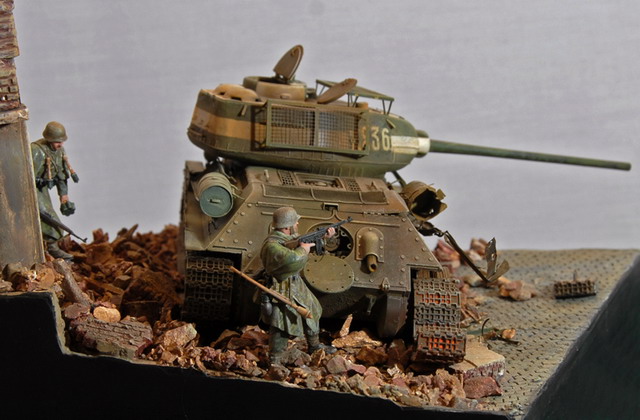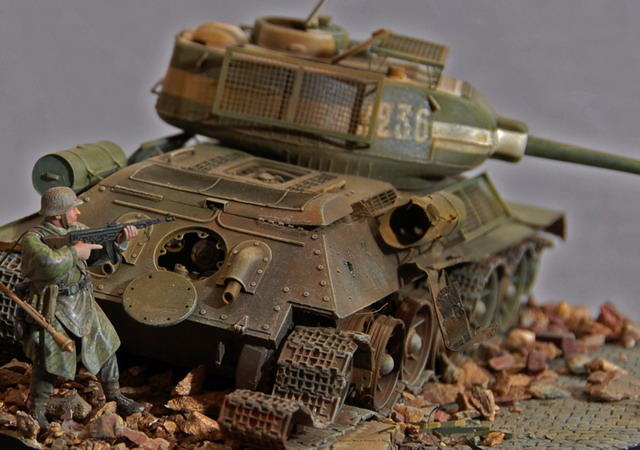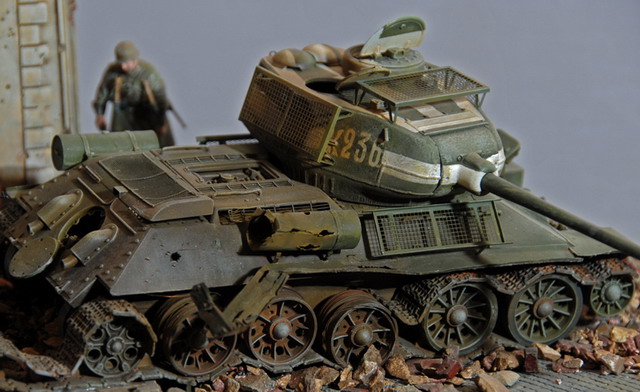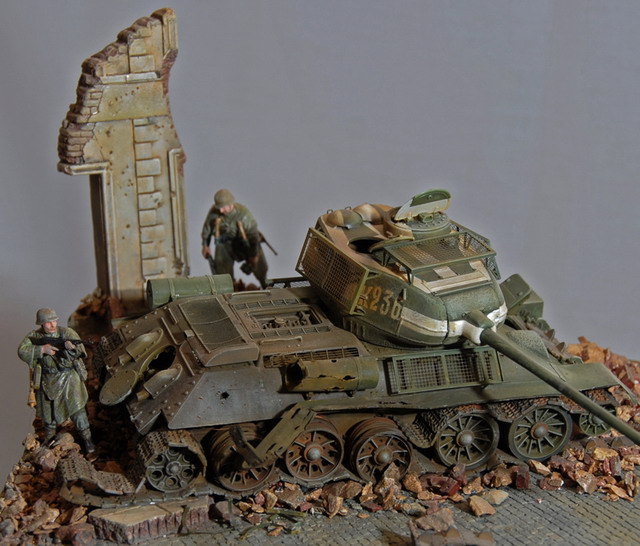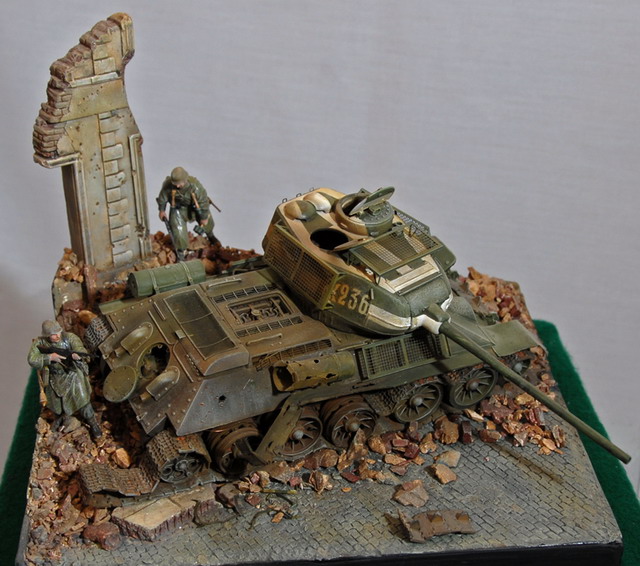Joaquín Pérez
Río Gallegos - Argentina
Volver al Indice de Amigos / Back to Index of Friends
Howitzer
Trumpeter - 1:35
Howitzer soviético B4 de 203mm Modelo 1931, de la marca Trumpeter, armado sin modificaciones, salvo por el agregado del magnífico tubo cañón en aluminio de la marca RB Model, al que le estuve "empolvando la nariz" con los pigmentos K4 y oleos varios. Los proyectiles de bronce, que vienen con la maqueta, están tan bonitos que me dio pena pintarlos.
203mm Soviet Howitzer B4 Model 1931, from Trumpeter, built without modifications, except for the addition of the magnificent aluminum barrel from RB Model, which I was "powdering the nose" with the K4 pigments and various oils. The bronze projectiles, which come with the model, I didn't want to paint them because they are so beautiful.
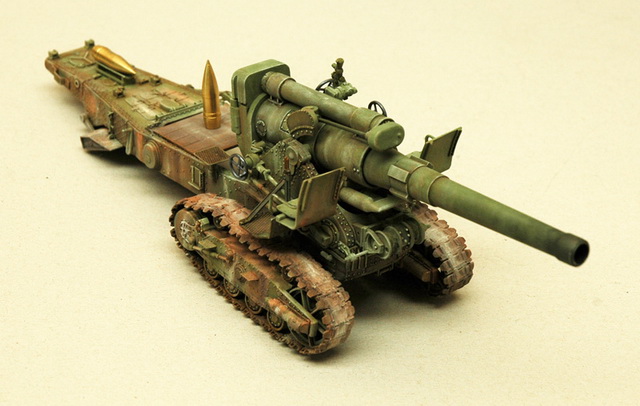

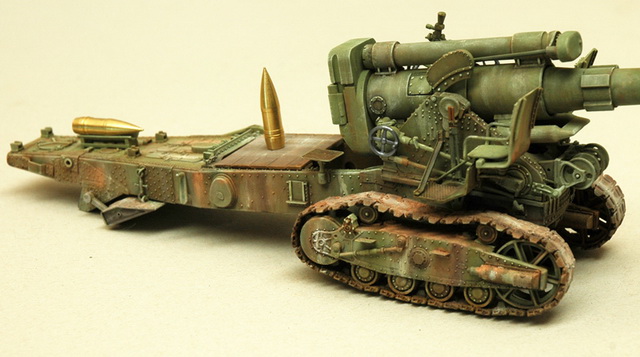
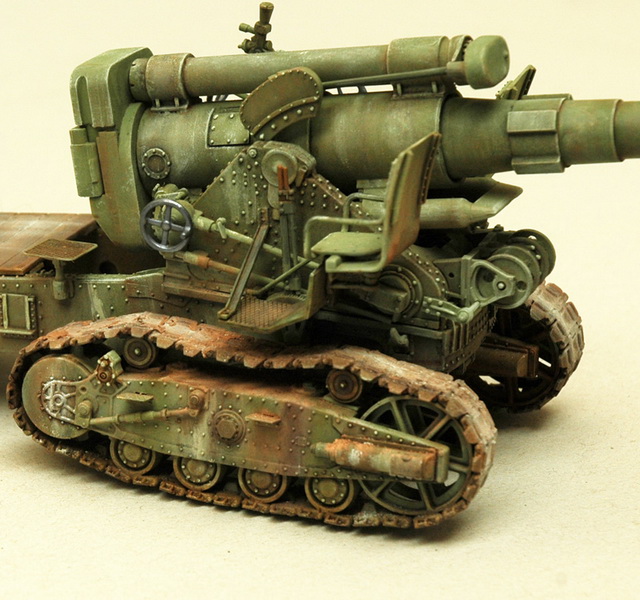


Cruiser Tank A27M Cromwell
Tamiya - 1:35
Cruiser Tank A27M Cromwell. La maqueta es la de Tamiya y los accesorios y la torreta con la "Hessian Tape" son de Black Dog. Pintura con acrílicos Tamiya y empolvados y lavados con productos de una marca que no conocía, K4, producidos en Chile, realmente muy buenos. La maqueta representa un vehículo del 15th/19th The King´s Royal Hussars, que fue la unidad de reconocimiento de la 11th Armoured Division desde el 17 de Agosto de 1944 hasta el 31 de Agosto de 1945.
Cruiser Tank A27M Cromwell. The model is from Tamiya and the accessories and the turret with the "Hessian Tape" are from Black Dog. Painting with Tamiya acrylics and powdered and washed with products of a brand that I did not know, K4, produced in Chile, really very good. The model represents a vehicle of the 15th / 19th The King's Royal Hussars, which was the reconnaissance unit of the 11th Armored Division from August 17, 1944 to August 31, 1945.
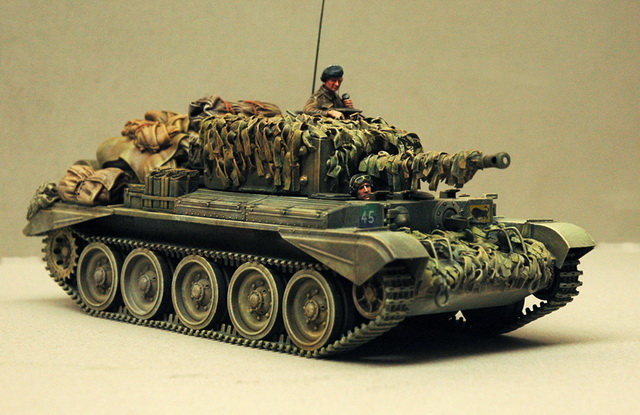
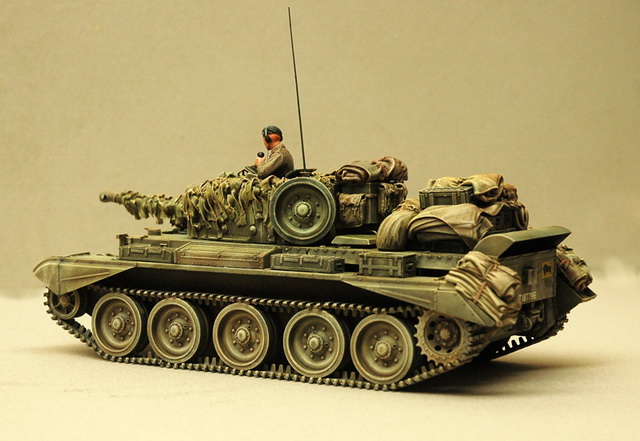
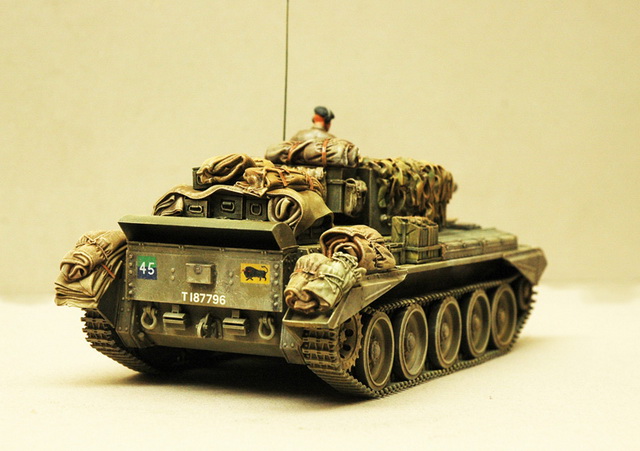
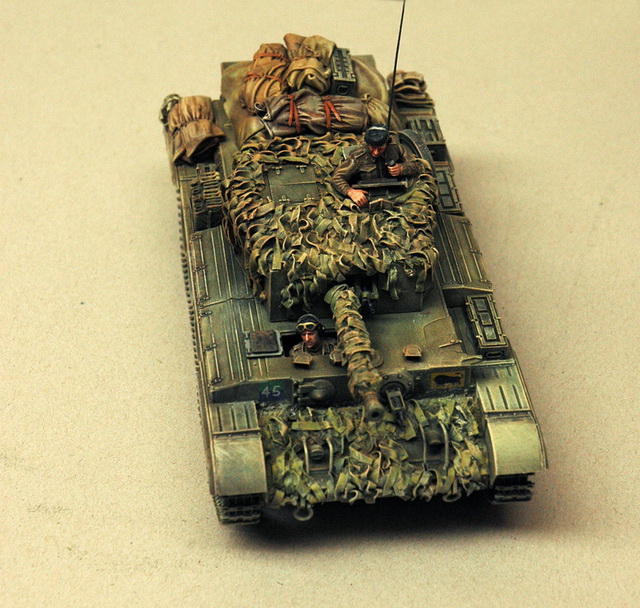


Sherman Firefly (M4A4)
Dragon / Tamiya - 1:35
Referencia Histórica
Una de las principales preocupaciones de los planificadores aliados con respecto al papel que las fuerzas acorazadas deberían jugar luego del Día-D, se relacionaba con las deficiencias de potencia artillera de los carros propios, en relación a los modelos alemanes que deberían enfrentar, especialmente los Tiger y Panther. Es cierto que la doctrina aliada asignaba a la artillería y la aviación de apoyo táctico la tarea de clavar al piso y luego destruir las fuerzas acorazadas enemigas, mientras que los blindados tenían como principal misión desarticular el dispositivo del adversario con profundas penetraciones basadas en la velocidad y sostenidas por un magnifico despliegue logístico, y que las eventuales pérdidas eran fácilmente reemplazadas por la potencia industrial norteamericana. Pero también era cierto que la deficiencia mencionada no solo podría tener consecuencias tácticas importantes, sino también ser muy corrosiva para la moral de las tripulaciones directamente involucradas en las acciones. La respuesta dada a esta situación por los norteamericanos fue la puesta en producción del M4A1 con cañón largo de 76 mm. y de parte británica por la incorporación del Sherman Firefly (luciérnaga), que montaba la poderosa pieza antitanque de 17 libras ( 76.2mm.). El anillo de la torre era apenas suficiente para absorber el potente retroceso del cañón, y fue necesario incorporar diversas modificaciones en el interior de la torreta, las más notables de las cuales fueron el desplazamiento del equipo de radio a una caja exterior soldada en la parte posterior de la torre, para dejar espacio para la carrera de retroceso del "17", el agregado de una escotilla cuadrada en el techo de la torreta sobre la posición del cargador y la eliminación de la ametralladora del casco, buscando mayor espacio para estiba de munición. Los Firefly fueron montados básicamente sobre dos modelos de Sherman: El M4 Composite Hull y el M4A4, llamado Sherman V por los ingleses, que fueron los principales usuarios de este modelo, ya que las únicas unidades norteamericanas que usaron el M4A4 fueron algunos Provisional Tank Battalions en el teatro China-Birmania-India, cuya principal tarea era la de instruir a las incipientes fuerzas acorazadas chinas. El Firefly entró en acción inmediatamente luego del Día-D y demostró ser una muy eficaz combinación antitanque y además de las fuerzas británicas, equipó también a las unidades polacas y canadienses.
La Maqueta
La marca DRAGON comercializa un Firefly sobre chasis de M4A4 (6031) y otro sobre casco compuesto(9037), que trae algunas planchas del primero. Como nunca pude conseguir el primero, que era el que quería tener, opté por combinar la torreta del segundo con el casco del M4 de TAMIYA (35190), al que convertí en un M4A4 utilizando las piezas del cubre motor que venían "de sobra" en el kit 9037 de DRAGON. Para que esto no parezca un despilfarro, diré que con el casco del Firefly y la torreta del M4 armé un M4 Composite Hull que, dicho sea de paso, me quedó muy bonito. En cuanto a la pintura, el carro recibió primero una mano de gris medio y luego una capa suave de Khaki XF-49, sobre la que se fueron aplicando capas de Khaki Drab, Flat Earth y toques de Olive Drab (todas acrílicas de TAMIYA) hasta lograr una tonalidad acorde al Khaki Drab británico. Luego, los habituales lavados con óleo tostado y sombra disueltos con aguarrás y pincel seco. El cañón lleva un mimetizado celeste y blanco, diseñado para romper su línea y confundirlo, a los ojos de los artilleros enemigos, con un Sherman standard. La maqueta representa un vehículo del The South Alberta Regiment ( 29th Armoured Recee. Regiment) de la 4th Canadian Armoured División, en el Reichswald, Alemania, a principios de 1945. La figura es una axcelente realización en resina de WARRIORS.
Historical Reference
One of the main concerns of the allied planners regarding the role that the armored forces should play after D-Day, was related to the deficiencies of artillery power of their tanks, in relation to the German models they should face, especially the Tiger and Panther. It's true that the allied doctrine assigned to the artillery and aviation tactical support the task of nailing to the floor and then destroy the enemy armored forces, while the armored had as main mission to disarticulate the adversary's device with deep insights based on the speed and sustained by a magnificent logistical deployment, and that the eventual losses were easily replaced by the North American industrial power. But it was also true that the aforementioned deficiency could not only have important tactical consequences, but also be very corrosive to the morale of the crews directly involved in the actions. The response given to this situation by the Americans was the production of the M4A1 with a 76 mm long cannon and a British part by the incorporation of the Sherman Firefly, which mounted the powerful 17-pound (76.2mm) antitank piece. The ring of the tower was barely enough to absorb the powerful recoil of the barrel, and it was necessary to incorporate various modifications into the turret, the most notable of which was the displacement of the radio equipment to an outer box welded in the rear of the tower, to allow space for the recoil stroke of the "17", the addition of a square hatch on the roof of the turret on the position of the loader and the removal of the hull machine gun, seeking more space for stowage of ammunition. The Firefly were basically mounted on two models of Sherman: The M4 Composite Hull and the M4A4, called Sherman V by the English, who were the main users of this model, since the only American units that used the M4A4 were some Provisional Tank Battalions in the China-Burma-India theater, whose main task was to instruct the incipient Chinese armored forces. The Firefly came into action immediately after D-Day and proved to be a very effective anti-tank combination and in addition to the British forces, it also equipped the Polish and Canadian units.
The model
DRAGON sells a Firefly on chassis of M4A4 (6031) and another on composite hull (9037), which brings some sprues of the first. As I could never get the first one, which was the one I wanted to have, I opted to combine the turret of the second with the M4 hull from TAMIYA (35190), which I converted into an M4A4 using the pieces of the motor cover that were left over in the kit 9037 from DRAGON. So that this doesn't seem like a waste, I will say that with the helmet of the Firefly and the turret of the M4 I built an M4 Composite Hull that, incidentally, was very beautiful. As for the painting, the tank received first a hand of medium gray and then a soft layer of Khaki XF-49, on which were applied layers of Khaki Drab, Flat Earth and touches of Olive Drab (all acrylics from TAMIYA) until achieving a tone according to the British Khaki Drab. Then, the usual washes with toasted and umber oils dissolved with turpentine and dry brush. The barrel has a blue and white camouflage, designed to break its line and confuse it, in the eyes of enemy gunners, with a standard Sherman. The model represents a vehicle of the South Alberta Regiment (29th Armored Reception Regiment) of the 4th Canadian Armored Division, in the Reichswald, Germany, at the beginning of 1945. The figure is an excellent resin embodiment of WARRIORS.
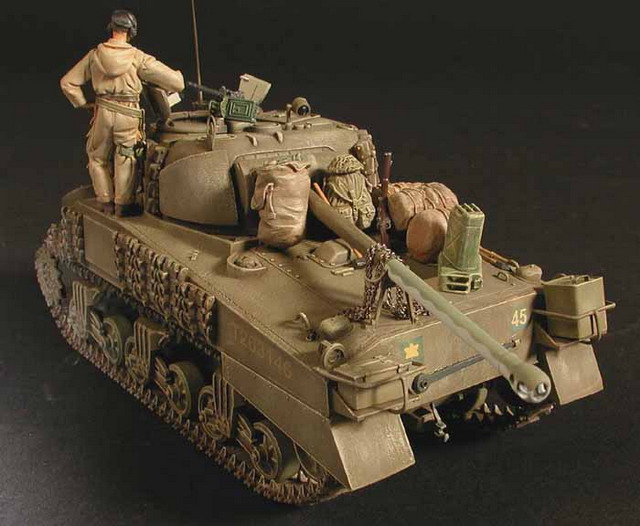
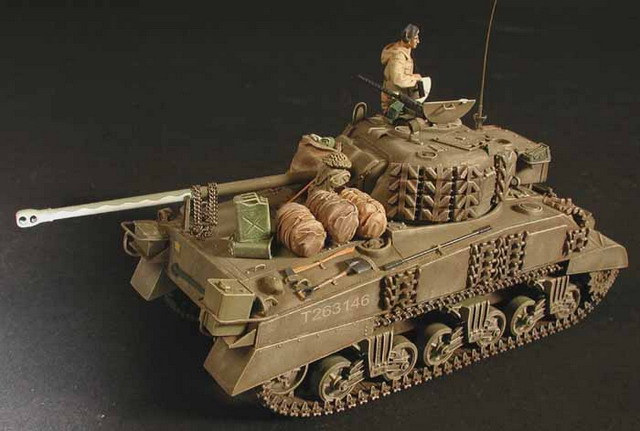
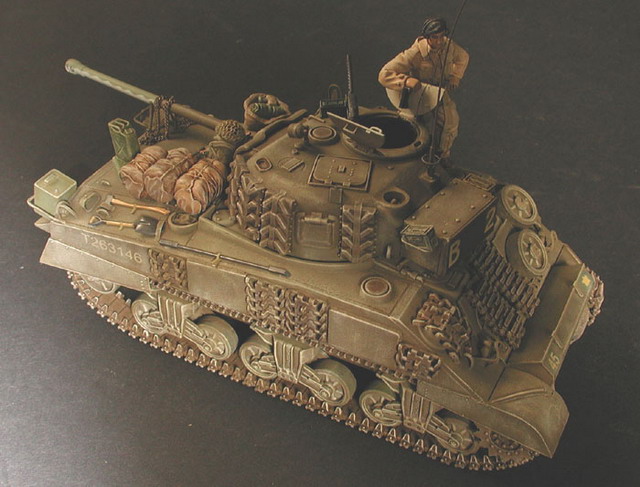
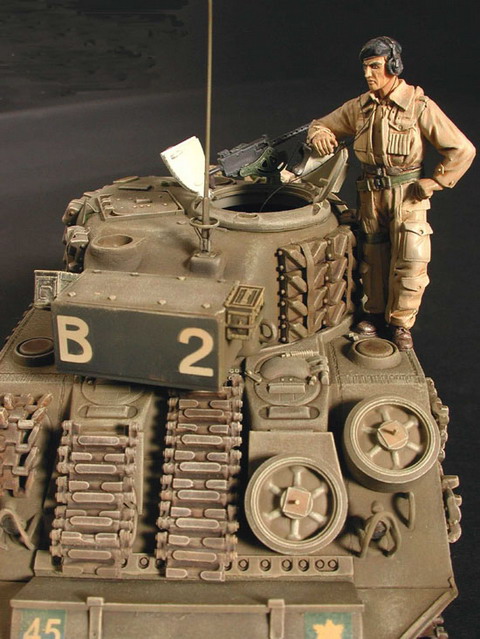
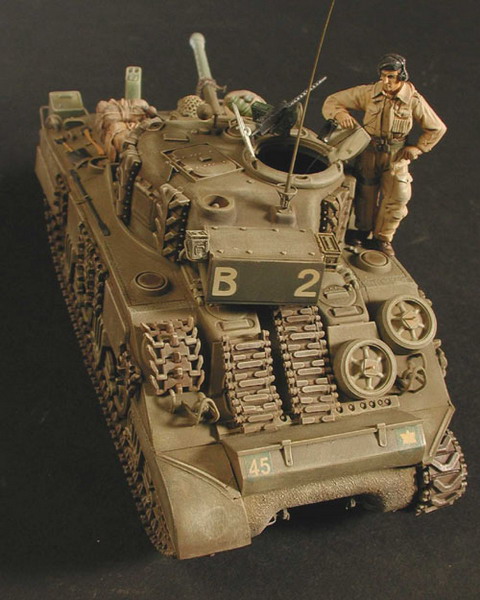
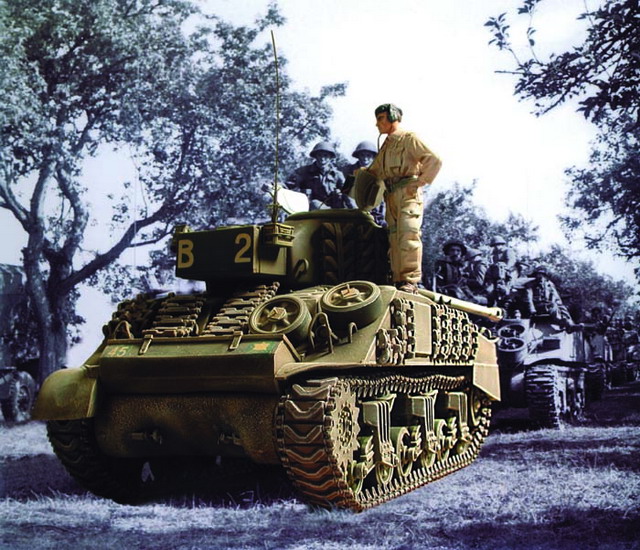
M4A3 (105 mm.)
Tamiya - 1:35
Desde la Patagonia argentina, Joaquín nos comenta que allí los inviernos son largos y hay mucho tiempo para armar y nos dice respecto a su diorama: "...M4A3 (105mm) de Tamiya, con un kit de equipo adicional de Legend, muy surtido, para vestirlo un poco. Las figuras que están sobre el vehículo son de Verlinden, y los infantes,Verlinden y Dragon. El terreno es enduido plástico, y luego cola diluida y arena fina distribuida desde un colador de te. El pasto, aserrín teñido mezclado con la viruta que se obtiene con el sacapuntas de un lapiz (el que parece un molinillo de café...);el charco es barniz común para madera y la "arboleda", un yuyo raro que encontré en la zona de Río Turbio, embebido en barniz para evitar que al secarse se desintegre, pintado con aerógrafo en marrón y naranja. Para lograr el eefecto del mimetizado blanco desgastado, utilicé un pedazo de esponja Mortimer (La verde finita), y a traves de ella le dí con aerógrafo algo de Alcohol "sucio" con Olive Green...y listo el pollo..."
From the Argentine Patagonia, Joaquín tells us that the winters are long there and there is a lot of time to build and he tells us about his diorama: "... M4A3 (105mm) from Tamiya, with an very assorted additional equipment kit from Legend. The figures on the vehicle are from Verlinden, and the infants, from Verlinden and Dragon.The ground is plastic coated, and then diluted glue with fine sand distributed from a tea strainer. The grass, dyed sawdust mixed with the shavings obtained with a pencil sharpener (the one that looks like a coffee grinder), the puddle is common varnish for wood and the trees, a rare weed that I found in the area of Río Turbio, imbibed in varnish to prevent it from drying up, disintegrating, airbrushed in brown and orange To achieve the effect of the worn white look, I used a piece of Mortimer sponge(the thin green one), and through it I gave him some airbrush "dirty" alcohol with Olive Green".
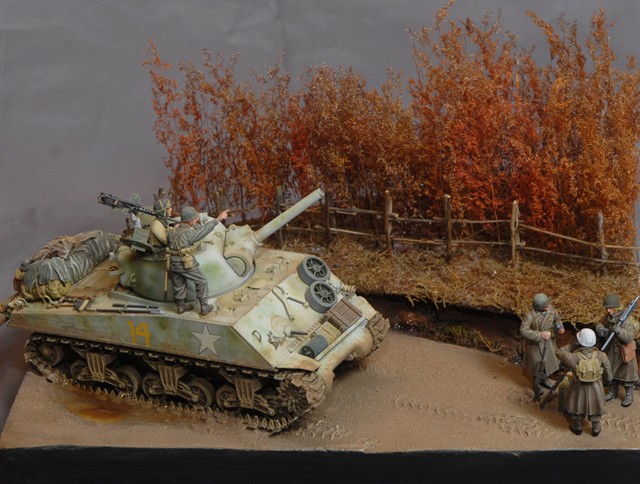
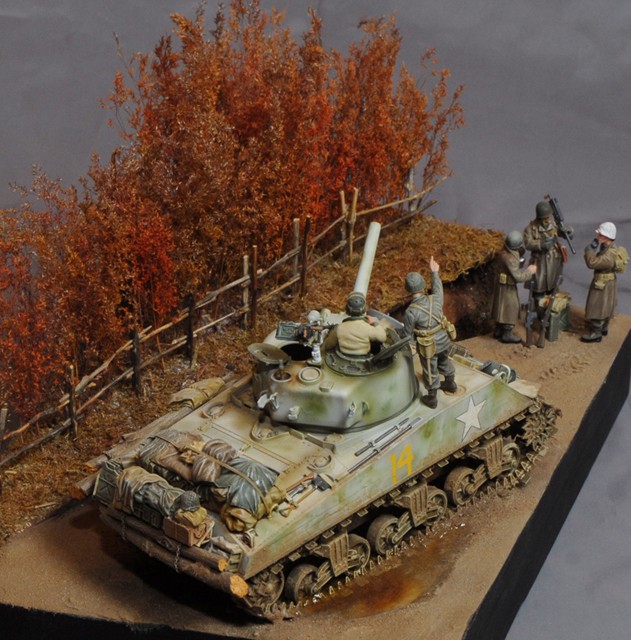
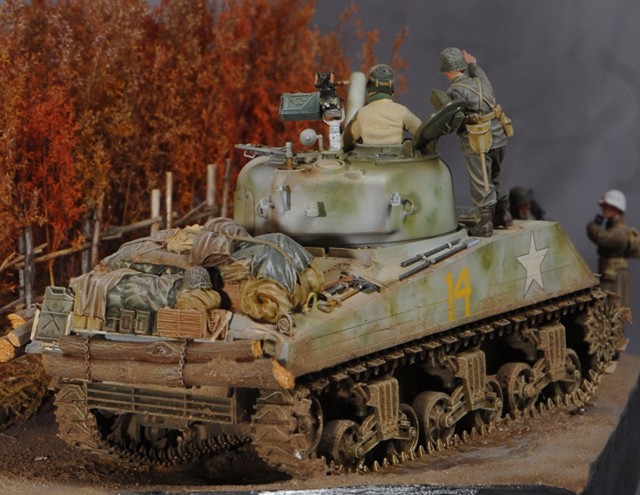
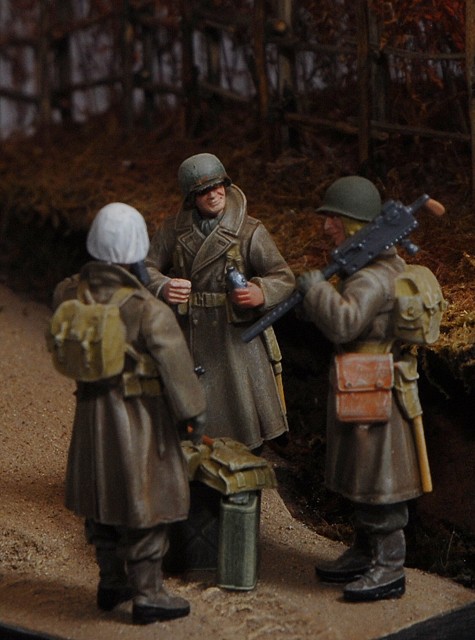
Hetzer
Dragon - 1:35
El cazacarros Hetzer es el viejo Dragon, mejorado con orugas metálicas Friullmodel, kit de motor de Verlinden y PE de Eduard. La planta baja de la construcción es una ruina de Custom reformada (el original era una ochava) y el primer piso y la calzada son de construcción propia, realizada en yeso, con las aberturas y persianas en varilla de pino. Las figuras son de Dragon, con cabezas Hornet. Todo pintado con las viejas y queridas Humbrol, con lavados de aguarrás y óleo Alba, pincel seco y a otra cosa.
The Hetzer tank destroyer is the old one from Dragon, enhanced with Friullmodel metal tracks, Verlinden motor kit and Eduard PE. The ground floor of the building is a reformed Custom ruin (the original was a corner) and the first floor and the roadway are self-built, made of plaster, with openings and blinds in pine rod. The figures are from Dragon, with Hornet heads. All painted with the old and beloved Humbrol, with washes of turpentine and Alba oil, dry brush and that is all.
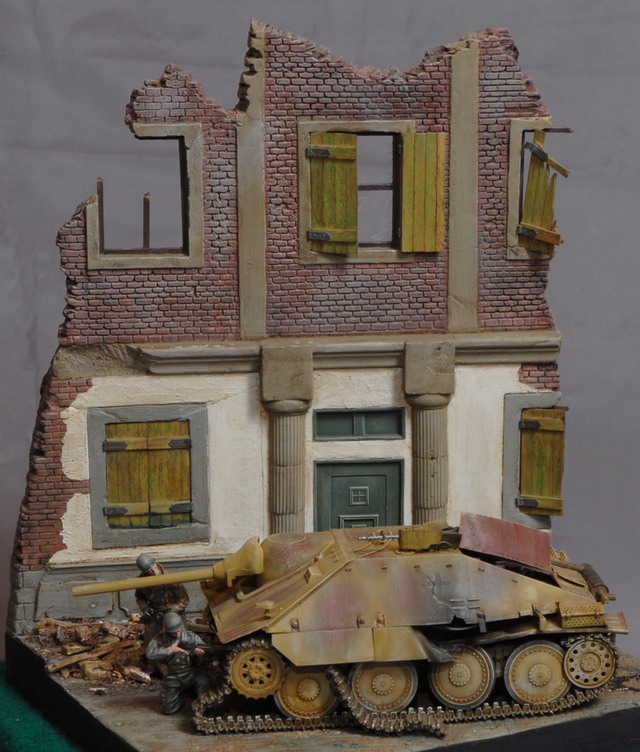
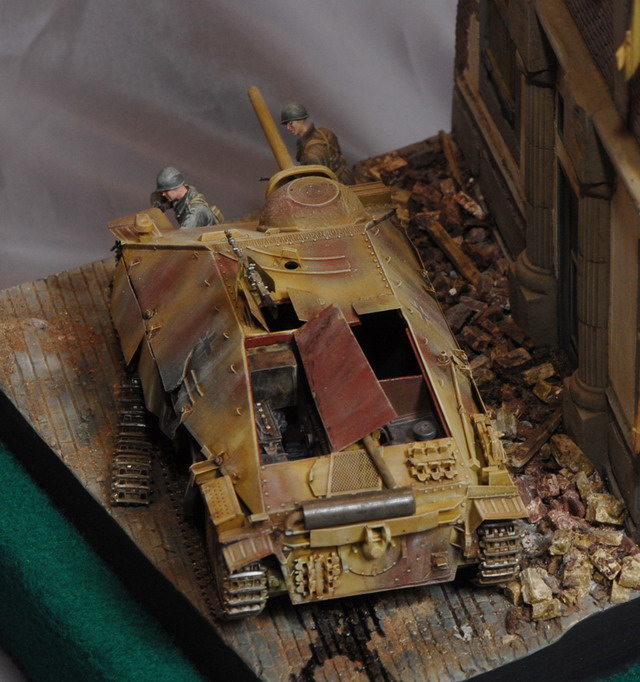
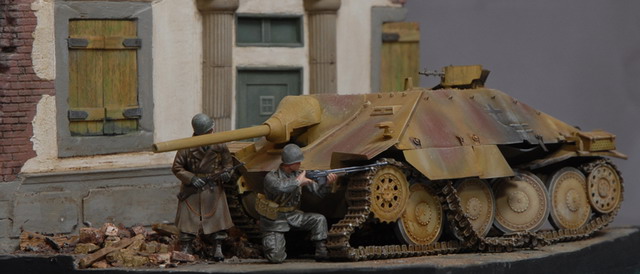
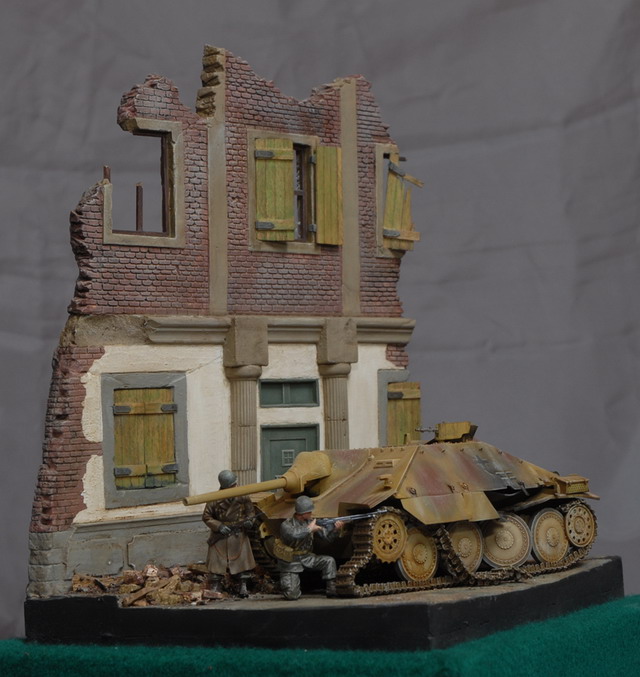
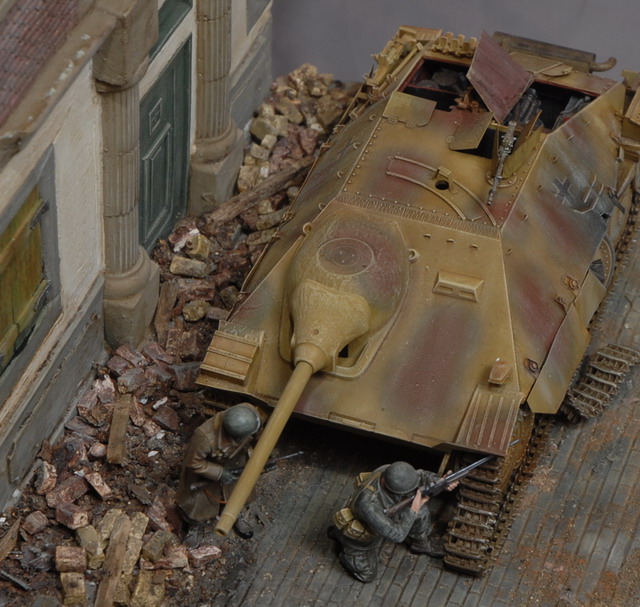
T-34/85
Tamiya - 1:35
El T-34/ 85 es de Tamiya, con orugas Dragon, ruedas quemadas (llantas) de resina (no recuerdo la marca) y un kit de fotograbado Aber, del que francamente se usa menos de la mitad, si es que uno pretende mantenerse mas o menos cuerdo...Las figuras son de Dragon y la ruina es un trozo que sobraba de un edificio de Verlinden, que utilicé en un diorama un tanto mas grande. Empedrado y cascotes, propios, de yeso. Vehículo y ruinas pintado todo con Humbrol, y las figuras con Vallejo, que la verdad me están dando un resultado bárbaro, y además tienen un envase que permite usar porcion es muy pequeñas, con lo que terminan resultando bastante económicas...Consabido "jugo" de aguarrás con algo de óleo tostado y pincel seco, para terminar.
The T-34/85 is from Tamiya, with Dragon tracks, burnt wheels (rims) made of resin (I don't remember the brand) and an Aber photo-etching kit, of which frankly less than half is used, if one intends to stay more or less sane... The figures are from Dragon and the ruin is a piece that was left over from a Verlinden building, which I used in a somewhat larger diorama. Paved and rubble, of my own, from plaster. Vehicle and ruins painted all with Humbrol, and the figures with Vallejo, that really are giving me a great result, and they also have a jar that allows to use very small portions, which ends up being quite economical... "Juice" of turpentine with some toasted oil and dry brush, to finish.
